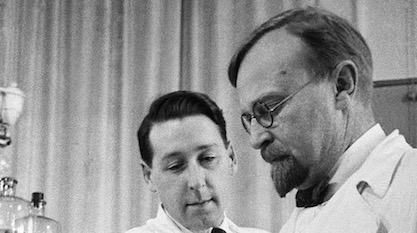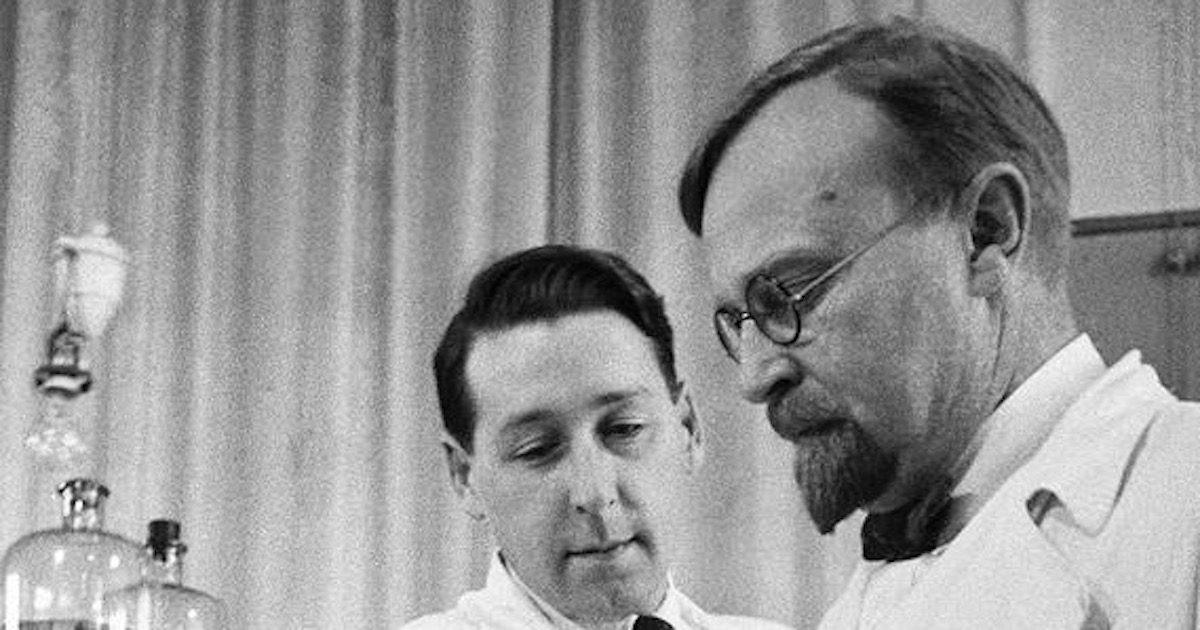 Evolution
Evolution
Not Oparin’s Coacervates Again!


The “warm little pond” idea was a mere suggestion when Darwin wrote to Joseph Hooker in 1871, a year before his death, but it was too vague to be taken seriously. Over 50 years later, in 1924, Alexander Oparin developed the idea with a little more rigor. He did so with the help of J.B.S. Haldane, speculating on how building blocks of life could be contained inside temporary droplets of organic goo. Wikipedia says, “For decades the theory of Oparin and Haldane was the leading approach to the origin of life question,” adding, “However, the lack of any mechanism by which coacervates can reproduce leaves them far short of being living systems.”
Also lacking was any mechanism for the transition from chance droplets to the elaborate lipid membranes in modern cells, with their active transport machines and sensory cilia. Considering that membranes are formed and regulated under the direction of nuclear codes, their likeness to chance droplets seems as strained as comparing cells to soap bubbles.
“Blobs of Protoplasm”
In his books including the latest one, Darwin Devolves (p. 18), Michael Behe has recounted the Victorian concept of cells as mere “blobs of protoplasm” about as simple as jelly. That simplistic notion had to yield to 20th-century realizations of cells as entities as complex as cities. Cellular cities, moreover, are surrounded by walls and gates of stunning complexity that carefully regulate what enters and exits.
Coacervates, by contrast, are at the mercy of chemical laws of osmosis. Only by chance would a droplet encircle a combination of “good” molecules. Even then, nothing would activate them to work cooperatively. And even if they did, waste products of imaginary primitive “metabolism” would accumulate, and be just as likely to overwhelm the interior as desirable ingredients. The desirable molecules, moreover, would be just as likely to escape as the waste products, resulting in droplets full of toxins.
Applying the most generous imagination to the picture would still fail to account for how the whole coacervate came under the control of a genetic code, which, in turn, would have needed to invent the code to replace the “skin” of the droplet with a lipid bilayer membrane capable of active transport. After all, a “coacervate” is just “a reversible aggregation of liquid particles in an emulsion.”
Fantastically Unworkable
The whole picture seems fantastically unworkable, considering that natural selection (whatever it might be capable of) could not operate before accurate replication was in operation. But what else do evolutionists have? Nothing. Nature abhors a vacuum, and so does PNAS, so some have decided to either look forward to “new physics” (Nature), or look back to Oparin’s vision (PNAS) and introduce a “new-and-improved” coacervate model. New Scientist makes the connection to Oparin:
Membrane-less droplets were a key element of the first popular hypothesis for life’s origin, which was set out by Russian biologist Alexander Oparin in the 1920s. However, the idea fell out of favour when it emerged that all cells have membranes.
The idea is now being re-assessed, says Kate Adamala of the University of Minnesota in Minneapolis. She suspects that life went through a “membrane-less stage” and that membranes only arose later. [Emphasis added.]
Reporter Michael Marshall titles his article, “Early life on Earth may have existed as miniature droplets of jelly.”
Calling Mike Behe: Please Comment!
The paper on which this notion is based is by Jia et al. in PNAS, “Membraneless polyester microdroplets as primordial compartments at the origins of life.” These are better than coacervates, they argue, since they are more stable when diluted. But they retain all the other problems of coacervate theory. Have scientists learned nothing since Oparin? Turn on your imagination, and charge back to the future! Or is it charge forward to the past?
The prebiotic milieu was likely heterogeneous, consisting of a large number of chemicals and their associated reactions, including those not only of biological compounds, but also nonbiological compounds. Although origins of life research has focused primarily on biological molecules, the nonbiological molecules which were also present may have assisted evolving chemical systems in unforeseen ways. Thus, we synthesized and assembled membraneless polyester microdroplets from drying of pools of simple α-hydroxy acid monomers and showed that they can act as plausible prebiotic compartments. By having the capacity to undergo combinatorial rearrangement, these microdroplets could have developed versatile abilities to host early genetic and metabolic systems critical for the origins of life.
The new coacervates wear polyester suits! Oh, the questions that leap up from these suggestions. Have they done no probability studies? Their suggestion of “combinatorial rearrangement” runs smack into the fact that they have chance, and only chance, in their toolkit. If pigs had wings, these microdroplets “could have developed” genetic and metabolic systems by chance. No, they could not. ID scientists like Douglas Axe have run the numbers (see Undeniable, Chapter 10). He found that the chance of getting a single modest protein is so vanishingly small, it would never happen during the entire age of the universe (see Illustra Media’s memorable animation of the problem in a clip from Origin, “The Amoeba’s Journey”). And even if it did, it would be a lifeless, useless strand, all by itself, destined to disintegrate in the next wetting and drying cycle.
Tall Impossibilities with a Single Bound
The faith of origin-of-life theorists is beyond outlandish. What holds it together is hope in the word “could” and other suggestive terms that conjure up visions of SuperChance leaping over tall impossibilities with a single bound:
These compartments can preferentially and differentially segregate and compartmentalize fluorescent dyes and fluorescently tagged RNA, providing readily available compartments that could have facilitated chemical evolution by protecting, exchanging, and encapsulating primitive components. Protein function within and RNA function in the presence of certain droplets is also preserved, suggesting the potential relevance of such droplets to various origins of life models. As a lipid amphiphile can also assemble around certain droplets, this further shows the droplets’ potential compatibility with and scaffolding ability for nascent biomolecular systems that could have coexisted in complex chemical systems. These model compartments could have been more accessible in a “messy” prebiotic environment, enabling the localization of a variety of protometabolic and replication processes that could be subjected to further chemical evolution before the advent of the Last Universal Common Ancestor.
The word “could” appears 34 times in the paper, “suggests” and similar words 20 times, “possible” and similar words 13 times, “likely” 11 times, “may have” 8 times, and “perhaps” 3 times. The paper includes 12 movies of spherical drops bouncing around and occasionally merging. OK, so? You can observe that in the kitchen sink with soap bubbles in a dish. Then what happens?
As even this relatively simple system with only one synthesis step results in the emergence of distinct chemical traits, environmentally responsive dynamic systems may be common chemical phenomena as well as a facile way to select for microdroplets with specific attributes or functions advantageous for further chemical evolution.
But there were no functions! The droplets only coagulated or split up. What kind of function is that? Can you really compare that to cell division?
These microdroplets are relatively stable to coalescence, and their recombination and “division” can be effected through pH and/or ionic strength fluctuations in water in conjunction with agitation.
Shake and Hope
This “shake and hope” theory of coacervation is far, far more simplistic than one Jonathan Wells thought of. Put a live cell in a test tube, he said, and poke a hole in the cell so that its contents leak out. The experimental setup is perfect; all the components are there, including the ingredients for a genetic code, metabolism, and container. You can add a nice nutrient broth if you want. Everything a cell could ever need is all there in a non-living container (the test tube), ready to “undergo combinatorial rearrangement.” So go ahead; shake away, and see what happens! Even with shake-and-hope experiments running on every planet in the universe with these ideal conditions, the humpty-dumpty cell will not come back together again.
It’s hard to believe that this paper passed peer review and got published in one of the premier science journals in America. This is what happens in a one-party system of science run by materialists who forbid or ignore criticisms of their views. But “facts are facts,” as Science Magazine likes to say on its T-shirts. Banging their heads repeatedly against the facts of chemistry, evolutionists find some temporary relief in the world of imagination, even re-runs of science fiction from 1924. Now watch James Tour talk about facts in Science Uprising, and rise up!
Photo: Aleksandr Oparin (right) with Andrei Kursanov, 1938, by Pavel Troshkin, via Wikimedia Commons.
